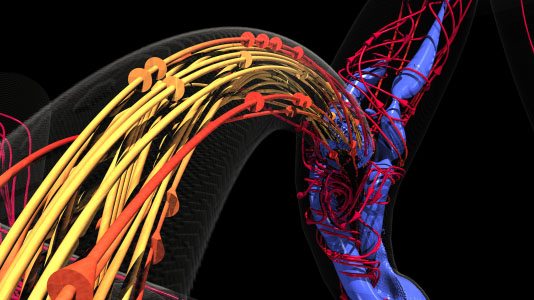| Oct 19, 2022 |
Four science advances coming in the exascale era
(Nanowerk News) One of the United States' first exascale supercomputers is being installed at Argonne National Laboratory. Named Aurora, its high computing speed and artificial intelligence capabilities will enable discoveries that are impossible today across a range of scientific domains, from climate and materials science to energy storage and fusion energy.
|
|
To prepare for Aurora’s arrival, 15 research teams are taking part in the Aurora Early Science Program through the Argonne Leadership Computing Facility. With access to early Aurora hardware and software, these researchers are preparing codes for the architecture and scale of the system.
|
 |
| One of the Aurora Early Science Program projects will use exascale computing power to advance cancer research by simulating how cancer cells move through the bloodstream. (Image: Joseph Insley, Argonne National Laboratory)
|
|
Here’s a look at some of the projects poised to make scientific breakthroughs on Aurora:
|
1. Mapping the brain’s complex connections
|
|
Argonne researchers are working to develop a brain connectome — a comprehensive map of all the connections in a brain. Such a map will allow researchers to answer questions like: How is brain structure affected by learning or degenerative diseases? How does the brain age? It’s the kind of research that was all but impossible until the advancement of ultrahigh-resolution imaging techniques and more powerful supercomputing resources.
|
|
“The compute time for a whole mouse brain would be something like 1 million days of work on current supercomputers. Using all of Aurora, if everything worked beautifully, it could still take 1,000 days,” said Argonne senior computer scientist Nicola Ferrier. “The problem of reconstructing a brain connectome requires exascale resources and beyond.”
|
2. Visualizing how cancer cells spread
|
|
Cancer cells can spread from one part of the body to another by traveling through blood vessels, a process known as metastasis. Understanding how this happens can guide the development of new drugs and treatments, but the process is still shrouded in mystery. A model that simulates blood flow through the body could predict the movement of cancer cells at a microscopic level.
|
|
“Tackling our new research into the process of metastasis and performing the intricate simulations needed means we need even greater computing power to handle the massive data sets in real time. The Aurora system will help us meet this need,” said Amanda Randles, an assistant professor at Duke University.
|
3. Easing the path to sustainable fusion energy
|
|
Fusion plasmas hold potential as a source of clean energy, but at ultrahot levels they need to be safely contained and their instabilities must be controlled. Scientists are developing predictive models to increase warning times of disruptions and work toward eliminating major interruption of fusion reactions in the production of sustainable clean energy.
|
|
“To make an economical fusion reactor viable, you really have to be able to predict and then control these disturbances,” said William Tang, professor of astrophysical sciences at Princeton University and principal research physicist with the DOE’s Princeton Plasma Physics Laboratory. “In order to train the predictor to achieve the high accuracy needed, you have to use the more powerful path-to-exascale supercomputers, and that’s what we’re doing right now.”
|
4. Speeding the search for the building blocks of the universe
|
|
Physicists have already discovered that there’s more to matter than protons, neutrons and electrons. But are there even more fundamental particles than quarks and leptons? That’s what researchers hope to find out by simulating collision events on exascale computing systems to inform experiments at the Large Hadron Collider.
|
|
“Fundamental research can give us knowledge that may lead to societal transformation, but if we don’t do the research, it won’t lead to anything,” said Walter Hopkins, an assistant physicist with Argonne National Laboratory.
|

